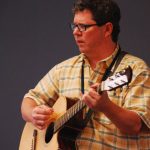 A Personal Approach to Guitar Education, By Bob Morris
A Personal Approach to Guitar Education, By Bob Morris
It is often difficult to convince school administrators and some teachers that guitar can be effectively taught in a classroom setting. They often have of a vision of disorganization with a cacophony of sounds coming from twenty-five guitarists–“doing their own thing.” But with guitar becoming increasingly more popular in schools, we now know that guitar instruction can meet the National Standards for Arts Education and provide a solid music education experience for students.
Most guitar classes focus on a multi-styled, multi-skilled curriculum. An approach that builds a foundation that can serve as a springboard to any style students want to pursue. At any given time, classes might be performing classical music, traditional folk songs, a reggae tune, a pop song, or rock-n-roll. The guitar is capable of playing any style of music, and should be taught that way. This is often what draws many students to Guitar, who would not typically sign up for Band, Orchestra, or Choir.
But beyond curriculum, the Guitar classroom looks just like the typical band or orchestra classes that have been in schools for years. In Guitar, students sit in rows or semi-circles and play and sing in a large ensemble. Students are tested both in written form and with playing exams. They even prepare for solo and ensemble contests in some school districts. In addition, as with most music classes, a concert is an expected event, that occurs often twice a year.
Large classes of twenty-five to thirty students make teaching both challenging and rewarding. When we discuss music, my students hold the guitars strings-down across their legs. When we play, we do so as a group. It is important that students quickly develop the discipline required of ensemble players.
In preparation for a concert, we learn new skills together and divide the class into sections for guided practice in melody, chords, and bass. The students switch parts to ensure that everyone masters all the new techniques. Then a piece of music is selected that emphasizes the new skills, and we play as a large ensemble, accompanied by a drum machine, electric bass guitar, and often our own vocals.
Most of the skills needed for a holiday performance are attainable in the first few months of school. From a curriculum standpoint, students will have mastered the notes on strings 1,2,3 and 4, they will know 6-8 open chords, and be able to create a bass line off of the root of each chord. By dividing the class into three sections–melody, rhythm, and bass–a diversified concert program can be achieved.
When you teach a child to play the guitar, they never seem to be bored. Their fantasies and dreams fuel their interests in developing their skills. After only four months of instruction, they are able to play and sing in an ensemble of more than a hundred guitars for their parents and friends. This accomplishment provides tremendous motivation for them to grow and develop as life-long musicians.
[social_button button=”facebook” furl=”http://www.facebook.com/pages/Teaching-Guitar-Workshops/98983006090?ref=ts&fref=ts” flayout=”standard ” fwidth=”450″ faction=”like” fcolorsheme=”light”]